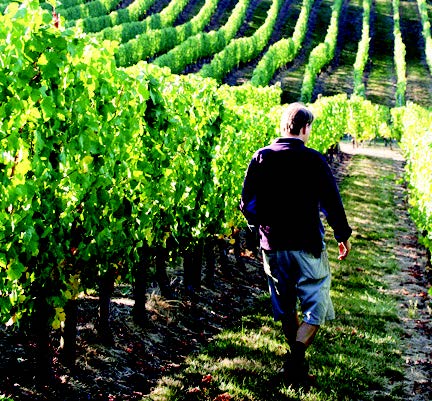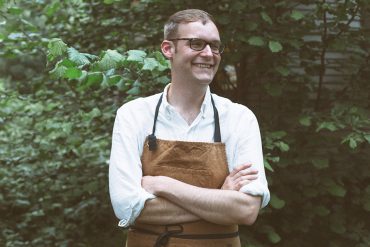Brian Marcy and Clare Carver live by a seemingly simple creed: eat, drink, enjoy. In heeding this doctrine, Carver, 37, a graphic artist, and Marcy, 40, a winemaker from Napa Valley, were raising chickens and growing food on a 7,000-square-foot lot at their home in the renowned California wine region.
Convinced that the best food and wine require the finest, freshest ingredients, they searched for land they could afford, so they could grow their own grapes and raise animals.
By 2006, they had laid claim to 70 acres in Gaston, a blink of a town at the northern edge of Oregon’s wine-growing region 23 miles west of Portland. Marcy and Carver gave it the name Big Table Farm, and began raising free-range poultry, pigs, cows, and egg-laying chickens. Creating a vineyard—particularly on land that hadn’t been farmed for more than half a century—is a slow and expensive process. In the interim, the couple has been leasing land at other vineyards and buying grapes, mostly from Willamette Valley farms with environmentally responsible farming practices. Since their first Pinot, Syrah and rosé were released in 2006, they have earned high marks.
“My wine making is very hands-off. I just sort of guide the grapes, and they make the wine themselves,” says Marcy. “I don’t add yeast or enzymes or modern winemaking ingredients. It’s a really old process. People have been making wine for thousands of years, and additives have only been around the last fifty. With just a little bit of thought, there are lots of other ways to do it.”
The Wine Advocate, called the 2006 Big Table Farm Syrah “superb,” and gave it 90 points, citing its blackberry and acacia flower notes, good acidity, and “beautiful purity and length.” Last fall the San Francisco Chronicle picked the 2008 Big Table Farm Resonance Vineyard Yamhill-Carlton Pinot noir as one of the top Pinot noirs of the year, acknowledging a “burnt orange peel, sweet extracted cherry and a bell-clear cranberry highlight, with a mineral edge.” In February, The Oregonian chose that same wine as a top Pinot, for its silky texture, lightly spiced baked fruit flavors, and even the “keepsake-worthy” label featuring Carver’s drawing of resident cow, Josephine, smiling.
Josephine has good reason to look content on that label. When Marcy and Carver were looking for farmland, they were reading Michael Pollan’s 2006 book, The Omnivore’s Dilemma, seminal in the small-farm movement. In part, it profiled Joel Salatin and his small-scale ecological rotation farm in Virginia, where he adheres to natural conditions as closely as possible, recycles waste and uses few artificial products.
“It really struck a chord,” says Carver. Soon the couple adopted a managed intensive grazing system and farming methods that would build the soil and sequester carbon. For example, their pigs, chickens and organic egg-laying hens move around the farm to fresh, clean grassy grazing areas. The wheel-mounted “winnapigo” and “chicken bus,” made with scrap metal from the property, provide shade, rain protection and rainwater troughs at each fresh grazing site. Solar-powered electric fences keep the pigs, cows, horses and goats on alternating stretches of land at a time. The only fertilizer at the farm comes from the grazing animals.
Carver uses her newly-trained team of draft horses to pull a harrow, a raking tool that looks like a section of chain link fencing, and aerates and spreads manure. The low-emissions horse-powered plow is in line with their lofty aspiration–certified biodynamic farming. Beyond the standards of organic farming, biodynamic farming certification looks at the entire farm as one self-sustaining organism. “I look at it like yoga,” she says. “You practice, and maybe someday you attain a proficiency level.”
Producing meat is just one of several lines of business the couple runs.
There’s the winery, Marcy’s winemaking consulting, seasonal dinners at the farm’s big table, and Carver’s graphic design and painting. “I realized we need to have weekly meetings—just the two of us—to plan and make sure we were on the same page,” Marcy says.
Clearly, living and working that closely with another person is challenging, Carver says. This is a situation, however, that has strengthened their partnership. “It’s like my horses. If they both aren’t pulling their weight the same way at the same time, things get all catywompus and don’t work right.”
When things don’t work right, Marcy can often cook his way out of it. “You could be mad as hell at your husband, and then he makes a homemade pizza with prosciutto from one of our pigs that he cured, and kale and some other gorgeous thing, and you can’t stay mad,” Carver admits.
The final part of the couple’s creed—enjoy—largely involves sharing their food and wine with others, at their 16-foot-long table for which their farm was named. From their window, they can see the south-facing slope where, soon, they hope to plant their own acres of Chardonnay, Riesling and Pinot.
Cooking with Wine:
From growers to restaurateurs, chefs from some of the best restaurants around the state described how they use wine in their dishes.
At Le Pigeon in Portland, Gabriel Rucker, nominated as a 2010 James Beard Foundation Awards’ “rising star chef of the year,” estimates he uses up to nine cases a week in cooking. His most notable use of wine is in the beef cheek bourguignon, an adaptation of the classic French dish, in which Rucker braises the beef cheeks overnight in burgundy wine.
A new dish for spring is his version of French onion soup that includes pigeon marinated overnight in “cheap pinot,” and topped with a bone marrow crostini.
“(Sous chef) Erik Van Kley and I were talking about how to get pigeon back on the menu, and we were throwing ideas back and forth, and Erik said, ‘Why not put red wine in it? How about zinfandel?’” Rucker suggested the more subtle Pinot to not overwhelm the pigeon. “We let the wine be the stagehand rather than the star,” he says.
At The Dundee Bistro, founded in Dundee wine country by the Oregon wine pioneering Ponzi family, chef Jason Stoller Smith showcases the Willamette Valley’s finest wines and ingredients. He says that winemakers who dine there love the Manila clams (see recipe on p. 74), steamed with Oregon Pinot gris, and finished with butter, cream and parsley.
He also makes a dessert dish for which he macerates Oregon berries then steeps them in Oregon Pinot noir, with a little sugar.
“It’s great over ice cream and meats, where you wouldn’t necessarily expect it,” Smith says. It’s a perfect treat to serve, he says, during the International Pinot Noir Celebration in McMinnville in July, when hundreds of visitors converge on the area to celebrate the Oregon varietal.
At Cucina Biazzi in Ashland, wine is used to create variations of several traditional Tuscan dishes. Sous chef Shane Hardin says that, in summer, a lighter version of the classic Bolognese sauce for pasta employs white wine, chicken and pork. In winter, a more robust, comforting version is created with Chianti Classico, beef, pork and sausage. Both are scented with nutmeg and fennel and finished with cream and butter. Another dish Hardin likes in the cold months is spezzatino, a classic Tuscan dish of braised pork with prunes and cooked with Chianti Classico, sage, onions, garlic, tomatoes, chicken and beef stock. In summer, he uses Grecante white wine for a softer version of the dish.







